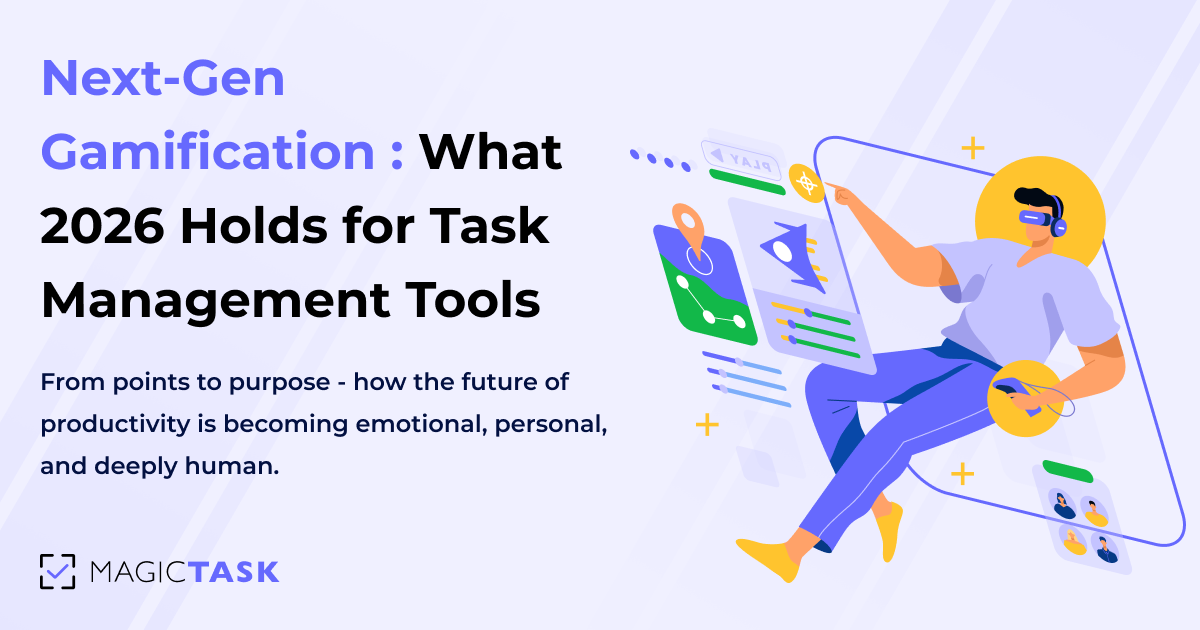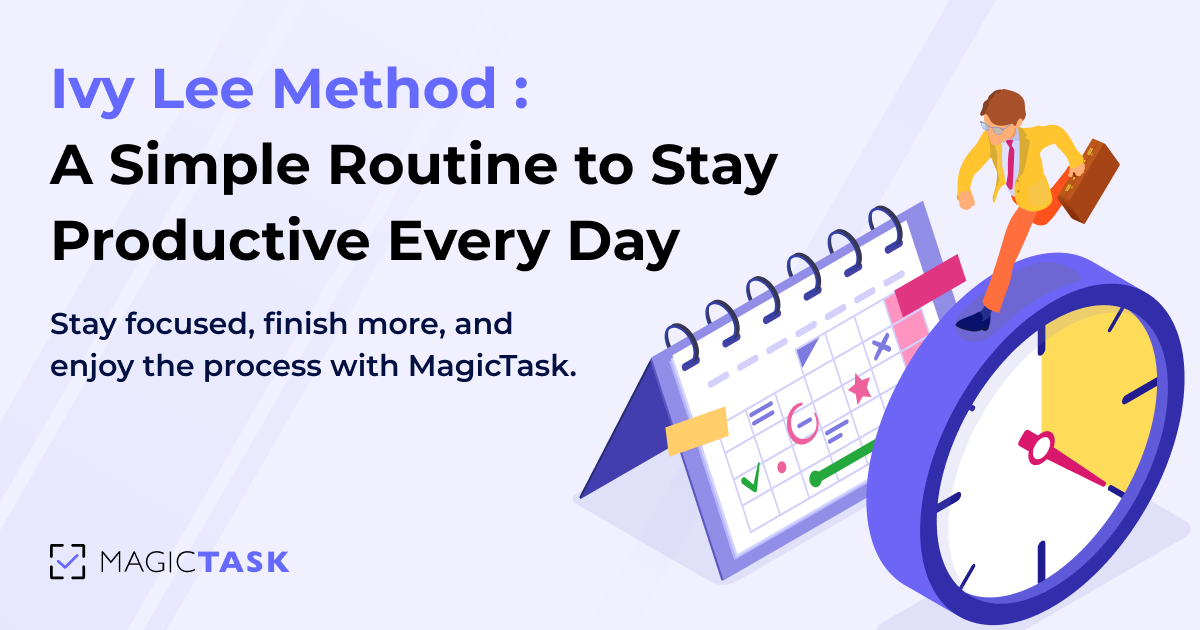ADHD in the Workplace: An Employer’s Guide to Boost Team Performance
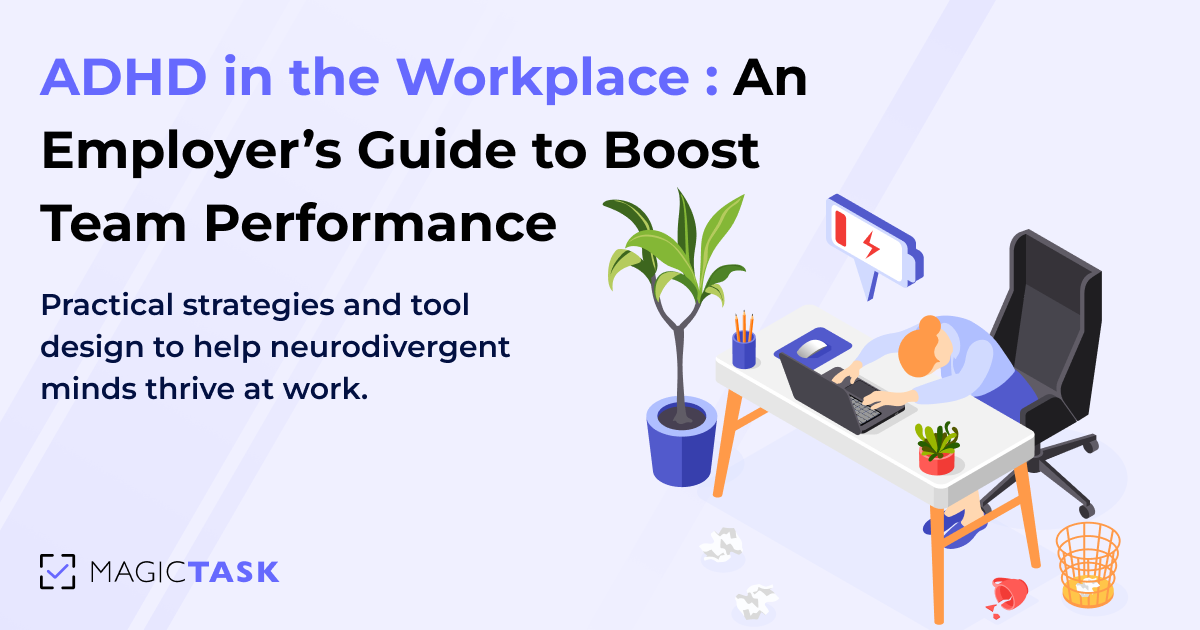
ADHD in the workplace is more common than many employers realise, and it directly affects performance, engagement, and team cohesion.
Around 5% of adults live with ADHD globally, which means in any average-sized team, at least one person is likely navigating work with difficulty.
While these individuals often bring creativity, innovation, and high-intensity problem-solving, traditional task systems tend to work against their strengths. When project workflows aren’t built to support neurodiversity, it leads to missed deadlines, dropped tasks, and team friction.
So how do you support ADHD minds without lowering the bar for performance, focus, or accountability?
That’s what this guide is for. You’ll gain a clear understanding of how ADHD manifests at work, what strategies are actually effective, and why a tool like MagicTask is designed to support neurodivergent teams without adding extra work.
What Challenges Do Employees with ADHD Face at Work?
Workplaces thrive on structure, prioritization, and consistency, yet those same elements can create hidden barriers for employees with ADHD. These individuals bring immense creativity, energy, and problem-solving ability, but often hit roadblocks in environments not built for neurodiverse thinking.
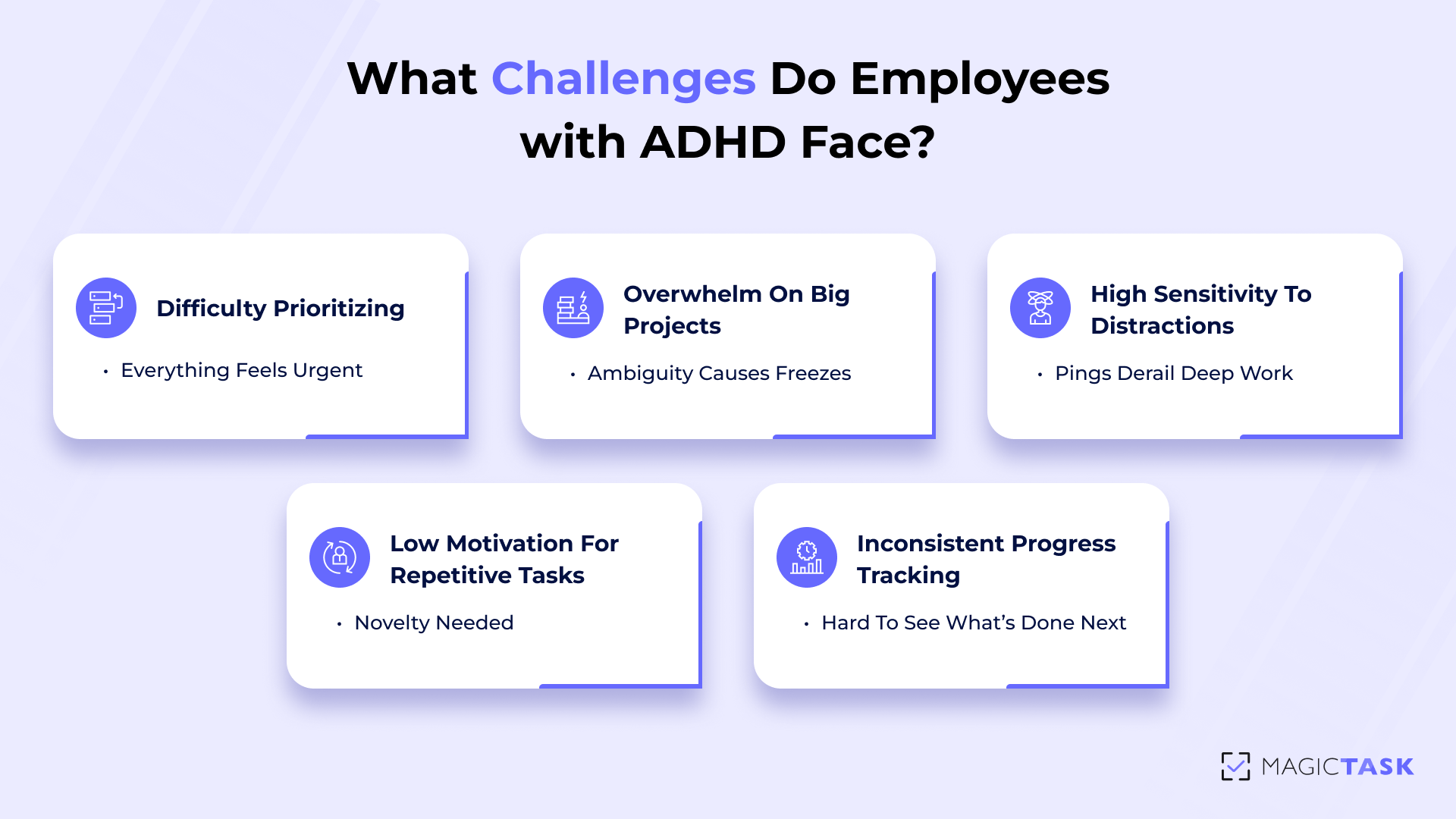
Difficulty Prioritizing Tasks and Deadlines
Employees with ADHD often struggle with executive functioning, which affects their ability to prioritize. When everything feels equally urgent, it becomes difficult to decide where to begin. This can lead to either hyperfocus on low-priority tasks or decision paralysis that delays all progress.
Some common challenges include:
- Overestimating small tasks and spending too much time on low-impact work.
- Underestimating large tasks, leading to last-minute rushes or missed deadlines.
- Difficulty sequencing tasks, unsure which steps need to come first.
- Getting distracted by novelty, diverting attention from important priorities.
- Feeling overwhelmed by lists, making it hard to choose a starting point.
Without visible priority cues, important deadlines may slip—not due to carelessness, but because internal urgency signals that neurotypical employees often rely on naturally are harder to generate.
Overwhelm When Projects Aren’t Broken into Smaller Steps
Large projects with vague goals can feel insurmountable to someone with ADHD. Without a clear breakdown into manageable tasks, they may freeze or procrastinate because the task feels too mentally ambiguous.
For example, “Create client report” offers no guidance on where to start or how to measure progress. Breaking it into steps like “Gather sales data,” “Draft analysis,” and “Design slides” makes it more approachable and achievable.
Sensitivity to Distractions
ADHD brains are often described as having a “racecar engine with bicycle brakes.” In today’s workspaces, filled with notifications, open office chatter, and multitasking demands, this sensitivity becomes a daily challenge.
Every ping, conversation, or visual clutter becomes a new stimulus to process. This makes it hard to stay in a productive state, especially for tasks requiring sustained focus or attention to detail. Even a well-intentioned Slack message can derail 20 minutes of deep work.
Struggles with Motivation During Repetitive Tasks
Routine tasks can quickly feel dull or draining for ADHD employees. Their brains are wired to seek novelty and stimulation. As a result, tasks that others find easy, like updating spreadsheets or processing similar tickets, can feel unbearable over time.
Motivation dips, and the task is either delayed or abandoned altogether. Without some form of positive reinforcement or novelty, the repetition becomes a mental roadblock.
Inconsistent Progress Tracking
Many employees with ADHD rely heavily on external structure to stay on track. Without visual progress markers or reminders, they may lose sight of what’s done, what’s next, and what’s important. This can lead to skipped steps, incomplete handoffs, or frustration when it’s time to report progress.
While neurotypical employees may be able to “hold the plan in their head,” ADHD team members often benefit from visual, structured systems that externalize priorities and milestones.
How Employers Can Improve Focus and Productivity (with MagicTask)
Understanding the challenges is only the first step. The next and most critical move is to take intentional action that supports how ADHD employees think and work best. MagicTask helps with this.
Break Work into Smaller, Clearer Tasks
Large, ambiguous tasks are a hidden productivity killer, especially for employees with ADHD. A task like “Work on campaign” or “Fix website issues” doesn’t provide enough clarity to trigger action. It leaves too much room for interpretation, which can result in procrastination, anxiety, or missed expectations.
That’s where task decomposition comes in. Instead of treating a deliverable as a single to-do, you break it down into main tasks and subtasks. This method offers two powerful benefits:
- Cognitive Relief: When a task is broken down into clear, specific steps, it instantly becomes more approachable. Employees no longer have to juggle all the pieces mentally; the structure does the heavy lifting.
- Actionable Visibility: Subtasks show exactly what needs to happen next. This helps ADHD team members maintain forward momentum, especially when switching contexts or resuming work after interruptions.
In MagicTask, breaking work into subtasks is fast and frictionless. You can:
- Create a main task (e.g., “Prepare Product Launch”)
- Add subtasks like “Write email copy,” “Design launch banner,” “Schedule posts,” etc.
- Mark off each subtask for visible progress and a sense of achievement
This approach turns ambiguity into action. It makes projects feel doable, keeps your team aligned, and ensures no detail slips through the cracks, especially for those who think differently.
Visualize Priorities as a Team
Clear priorities can make or break productivity, especially for team members with ADHD, who often struggle to decide what to tackle next when faced with a wall of tasks. Without a visual system to guide focus, even the most capable employees can lose momentum or fall behind.
In MagicTask, teams can drag and drop tasks into a clear, ranked order, making priorities instantly visible to everyone. No digging through layers of dashboards. No second-guessing what’s urgent.
This simple yet powerful interaction helps in three ways:
- Real-Time Alignment: Managers and team members can collaborate on the same view, quickly adjusting task order as deadlines shift or new blockers emerge. Everyone stays on the same page, without needing long status meetings.
- Mental Clarity for ADHD Brains: Seeing tasks laid out from top priority to low urgency helps reduce decision fatigue. ADHD team members know exactly where to direct their attention, which helps lower stress and increase follow-through.
- Frictionless Flexibility: With a quick drag-and-drop, tasks can be re-prioritized without rewriting or reshuffling complex lists. The interface stays clean and minimal, which reduces the clutter that often overwhelms neurodivergent users.
Visualizing priorities isn’t just good project hygiene; it’s how you turn daily work into focused progress for every mind on your team.
Clarify Complexity With Task Sizing
For employees with ADHD, the size of a task isn’t just a planning detail; it’s a psychological cue. A vague or oversized task like “Finish report” can feel insurmountable and trigger procrastination or mental fatigue. On the other hand, a well-scoped, appropriately sized task helps clarify effort, reduce overwhelm, and make progress feel possible.
MagicTask solves this with a simple but powerful feature: task sizing.
Every task can be marked as S, M, L, or XL, giving team members a visual sense of how much time and energy it will take. This sizing system helps ADHD employees pace their workload more effectively, balance high-effort tasks with lighter ones, and avoid burning out on hidden “time bombs.”
It also helps managers assign work more equitably. Instead of giving someone five tasks that look equal but feel wildly different in scope, you’re aligning expectations and removing ambiguity.
Here’s a quick way this plays out:
| Task Size | Time Needed | Example |
|---|---|---|
| S (Small) | 5–10 minutes | Reply to an email |
| M (Medium) | 30 minutes | Write a short status update |
| L (Large) | 1–2 hours | Draft a blog post |
| XL (Extra Large) | Half a day or a full day | Build a product roadmap |
This structure turns task planning into a confidence-building process and helps ADHD team members stay productive without mental overload.
Track Progress Easily with a Clear Hierarchy
ADHD minds often thrive with structure, not in the form of rigid rules, but as visual systems that reduce mental clutter and make progress visible. One of the biggest challenges in managing projects is seeing how the parts fit together. That’s why a clean hierarchy is essential.
MagicTask uses a simple but effective project → task → subtask structure that breaks down complexity into digestible layers. At the top, projects hold your high-level objectives. Within them, tasks represent actionable items. If a task is too big, you can split it further into subtasks — each with its own owner, size, and deadline.
This approach gives ADHD team members several advantages:
- No more overwhelm: When work is broken down visually, it’s easier to focus on the next small step instead of the entire mountain.
- Instant context: You can see what each task contributes to, helping employees connect daily work to larger goals — which boosts motivation.
- Better accountability: Managers can glance at a project and understand what’s moving and what’s stuck, without chasing updates.
Instead of relying on memory or scattered notes, your team has a clear visual roadmap, one that respects different working styles and keeps progress transparent at every level.
Why MagicTask Helps ADHD Minds Focus Better?
Many task tools are built for structure but not necessarily for focus. For professionals with ADHD, the biggest challenge often is staying engaged with the process of doing it. Overloaded interfaces, confusing navigation, and uninspiring task lists can quickly lead to frustration, avoidance, or inconsistent follow-through.
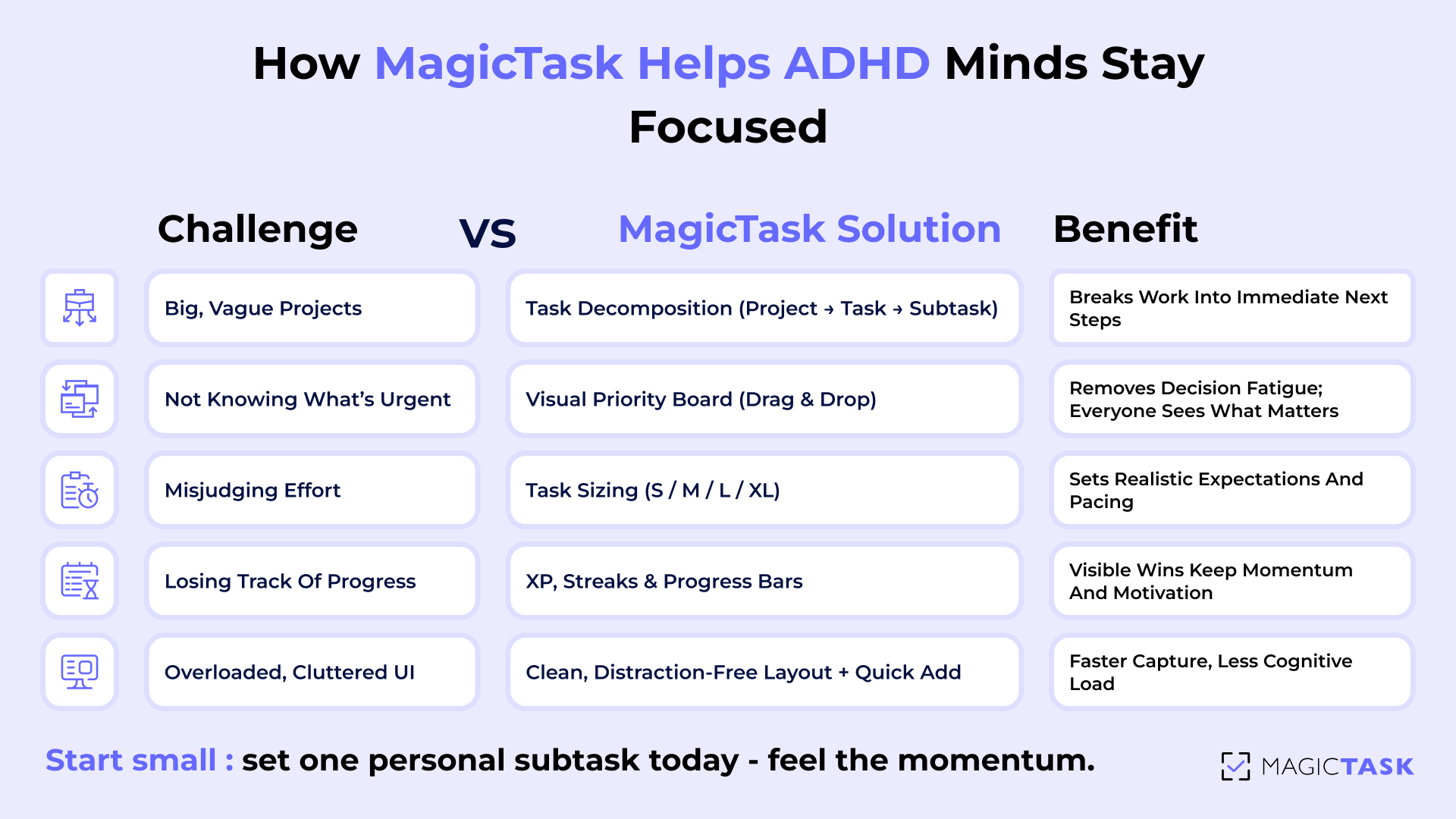
MagicTask takes a different approach. It’s intentionally designed to reduce friction and increase motivation, two things that ADHD brains thrive on when supported properly.
- Clean, distraction-free interface: Employees aren’t bombarded with options, tabs, or hidden menus. The layout is visually simple and intuitive, which helps eliminate cognitive overload and lets users focus on what matters right now.
- Quick setup, minimal ramp-up time: The platform avoids long onboarding flows and unnecessary complexity. This makes it easier for new users, especially those who feel overwhelmed by traditional tools, to adopt and stick with it.
- Gamification built for daily motivation: Users earn points for completing tasks and can unlock visual rewards like themes, sounds, and custom skins. This system adds a layer of intrinsic motivation that helps transform repetitive tasks into a more engaging experience.
These aren’t just features. They’re behavioral design elements that align with how neurodivergent minds operate. MagicTask doesn’t force users to change how they work. Instead, it creates a space where focus, momentum, and follow-through feel natural.
Management Practices That Work Better with MagicTask
Introducing a new tool is only effective if it’s paired with intentional practices. MagicTask is a framework for helping teams work smarter, stay engaged, and reduce mental clutter.
When managers and employees align on workflows and make the most of the platform’s gamification features, the result is a team that moves faster, communicates more clearly, and celebrates progress along the way.
Introduce MagicTask as the Single Source of Task Management
Consistency is crucial. By designating MagicTask as the central hub for all tasks, teams avoid fragmented communication and lost assignments. Managers should communicate that every project, deadline, and update lives in the same system. This establishes clarity, reduces confusion, and gives everyone a shared view of priorities.
Train Managers on Key Workflows
Managers play a pivotal role in making the system effective. Training should focus on workflows that both reduce cognitive load and leverage the app’s gamified structure:
- Mind Dump Sessions: Encourage team members to clear mental clutter by dumping all tasks into MagicTask before organizing priorities.
- Task Prioritization and Sizing: Teach managers how to help employees assign task sizes (S/M/L/XL), providing clarity on effort and expected focus.
- Comments for Centralized Communication: Use task comments to consolidate feedback, questions, and updates—keeping discussions tied to actionable items.
These practices create a rhythm where work feels organized rather than overwhelming, making it easier for employees to stay on track and managers to monitor progress.
Encourage Employees to Engage with Gamification Features
MagicTask’s gamified elements aren’t just for fun. They actively support motivation and focus. Managers can foster adoption by encouraging employees to:
- Personalize their workspace with themes that energize them.
- Stay motivated by climbing the leaderboard and celebrating small wins.
- Turn tasks into achievements using points, streaks, and visual rewards.
When these habits are reinforced, tasks stop feeling like chores and start feeling like challenges you can win, making focus and completion natural outcomes.
Conclusion
Supporting employees with ADHD isn’t just an act of inclusion, but a strategy that elevates team performance. MagicTask brings structure, clarity, and gamification together in a single tool, making it easier for everyone to stay focused, motivated, and organized.
By fostering an environment that meets diverse working styles, employers empower every team member, ADHD or not, to thrive, achieve goals, and perform at their best.
Ready to see the difference for yourself? Try MagicTask today and experience a task management system designed to work with your brain, not against it. Turn overwhelming lists into achievable wins, stay motivated with interactive progress, and finally enjoy a workspace that keeps you focused and energized, every single day.
Similar Blogs
FAQS?Have questions? Look here
ADHD affects executive functioning skills such as focus, prioritization, and task management. In the workplace, this can lead to difficulty meeting deadlines, managing distractions, and staying organized without proper support systems in place.
Common challenges include trouble prioritizing tasks, feeling overwhelmed by large projects, sensitivity to distractions, inconsistent progress tracking, and difficulty staying motivated during repetitive tasks.
Employers can help by providing clear task structures, breaking down large projects, offering visual workflows, minimizing distractions, and using tools designed to support neurodiverse working styles—like MagicTask.
Smaller, well-defined tasks reduce overwhelm and make it easier for ADHD individuals to focus and take action. Clear subtasks also help maintain momentum and improve follow-through.
Visual priority cues reduce decision fatigue and help ADHD brains quickly understand what to focus on next. Tools like MagicTask’s drag-and-drop priority view make this process intuitive and motivating.
Task sizing (S/M/L/XL) provides clarity on how much effort or time a task requires. This helps ADHD employees better plan energy levels, avoid burnout, and balance their workload more effectively.
Gamification adds motivation by turning work into a rewarding experience. Earning points, unlocking themes, and progressing on leaderboards encourages consistent engagement and reduces the boredom that often triggers procrastination.
Absolutely. MagicTask is designed to support all types of thinkers. While its clarity and motivation boosts help ADHD users, its streamlined workflows, prioritization features, and progress visibility improve productivity for everyone.
Managers can use task prioritization, sizing, centralized comments, and real-time updates to ensure everyone stays on the same page. The platform becomes a single source of truth, reducing confusion and miscommunication.
When ADHD employees receive the right structure and tools, they contribute higher creativity, stronger problem-solving, and fast-paced innovation. Supporting neurodiversity improves team performance, morale, and overall productivity.
